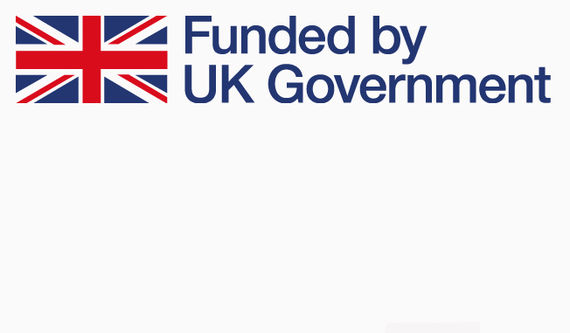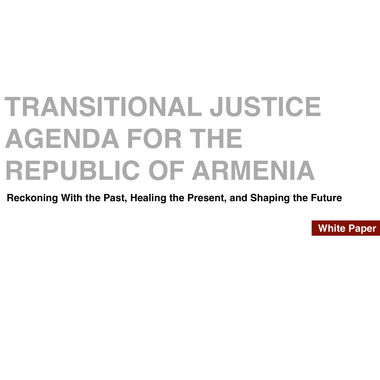Sun Jun 09 2019 · 11 min read
Armenia Gets Serious About Reforms: Making Sense Out of Vetting

By Nerses Kopalyan

Societies transitioning from repressive to post-repressive political systems generally subscribe to the broader democratization process, which, among a wide range of developments, also concerns the transitional state of the society. More concretely, societies that are democratizing also happen to be transitional societies, and one of the most important frameworks that transitional societies use to consolidate the democratic process is transitional justice (TJ).[1]
Transitional societies utilize transitional justice through two methods: comprehensively, where they develop a transitional justice program, or selectively, where they implement specific instruments of transitional justice. The broad research on transitional justice demonstrates that comprehensive transitional justice programs are far more successful than selective application of TJ instruments. However, it is not unusual for countries to begin applying TJ instruments while formulating and then implementing a more comprehensive TJ agenda. For transitional societies that utilize this approach, one of the most highly used TJ instruments is the concept of vetting. At the May 24 parliamentary hearings in Armenia’s National Assembly, this was precisely what Deputy Minister of Justice Anna Vardapetyan articulated: the necessity of implementing a process of vetting. In this context, as Armenia proceeds to formulate its TJ agenda, it will initially begin by applying the instrument of vetting.
Vetting is a transitional justice mechanism that falls, specifically, under the category of personnel reform mechanisms, and generally, under institutional reform mechanisms. As such, it is a form of “administrative” justice, where the operation of administrative agencies and institutions are regulated and reformed. Most basically, retroactive vetting involves the screening of individuals in public institutions, semi-public positions and/or loosely defined positions of public trust in order to verify that personnel have the integrity and capacity to fulfill their positions in a way that supports the goals and values of the new political system. In this context, vetting is a process that seeks to determine an individual’s integrity and suitability for employment in positions of public trust (public employment, position in state institutions, etc). The notion of “integrity” in vetting is qualified as an individual’s compliance to set standards of human rights, professional conduct, merit, competence, and financial propriety. Individuals who do not meet the set criteria mandated by the vetting process are excluded from positions of public trust. Exclusion may include two forms: termination of employment, and/or restricting access to employment.
As a TJ instrument, vetting is designed to “cleanse” state institutions that are tainted by systemic corruption, nepotism, and incompetence. Vetting of personnel is the first step toward the broader goal of institutional reform: concise application of vetting procedures allows for subsequent institutional reforms. It is for this reason that individuals found lacking in certain integrity or capability criteria are compulsorily removed from their positions, prevented from taking new positions, encouraged to voluntarily resign from positions or face public disclosure of their past, or alternatively, are required to confess past involvement as a form of accountability. Vetting measures seek to establish a break with the past and provide opportunities for state and societal rebuilding and reconciliation. Vetting measures must be designed to directly improve the trustworthiness and functionality of the new political system’s institutions and indirectly support the processes of democratization. More specifically, vetting, as part of a comprehensive TJ agenda, aspires to develop institutional trust among the citizenry, which is crucial for a transitional society’s progress in consolidating its democratization process.
Temporarily stepping aside from the comprehensive approach, and assessing the singular application of one instrument of TJ, we must pose the following question: What will or should Armenia’s vetting process look like? Armenia’s vetting measures require policy developments in five crucial areas that will contribute to the success of the process.
The first area concerns the institutions that vetting measures will target; namely, which institutions will be vetted, and more specifically, which positions within those institutions will be subjected to the vetting criteria? Second, and just as important, is the qualification of the criteria that will be used to implement the vetting measures. For example, what types of conduct, which forms of violations, and what modalities of performance will be included into the criteria structure when vetting individuals within the targeted institutions? The third area that will require robust policy development is the criteria for sanctions for those that fail the vetting process. Will the mandate for vetting demand termination from employment, forced retirement, temporary suspension, demotion, or other minimal-punitive measures? The fourth crucial area of policy development must concentrate on the design of the vetting process. Specifically, how expansive will the vetting mandate be, how will the vetting process be structured, and what procedures will be implemented to ascertain just and efficient results? And fifth, what will be the scope of the vetting process? That is, the number and type of personnel that will be vetted, and how this will shape the scope and extent of the vetting process.[2]
Who and What Should be Vetted in Armenia?
A broad range of comparative case studies demonstrate that vetting processes must be applied efficiently and specifically to certain institutions. Because vetting cannot be applied to the entire public sector of a country, it becomes imperative that the government both specify and justify which institutions will be targeted and why. An important part of this assessment must also configure whether entire institutions will be vetted, specific departments within the institutions, specific positions within the institutions, or specific categories across institutions. In El Salvador, for example, vetting processes primarily targeted the the security apparatus, both the police force and the military. In the Czech Republic, on the other hand, vetting measures were applied across a multitude of institutions based on special categories. For example, the categorical criteria in the Czech Republic was “collaboration,” and as such, individuals, regardless of the institution they worked at, were vetted according to this specific category. In Poland, vetting was specified to the political elite: the president, members of parliament, senators, and high-ranking officials.[3] Greece, in a more specific approach, targeted primarily the judiciary and academia, vetting universities and academics that either collaborated or promoted the junta.
In the case of Armenia, vetting measures will be most commensurate with the need to cleanse the following institutions: the judiciary, the Prosecutor’s Office, and the internal security apparatus (Police, National Security Service, and Special Investigative Service). The targeting of these institutions for vetting remains straightforward: the judiciary remains the most distrusted institution in Armenia, followed by the prosecutorial sphere, and then the internal security apparatus. Citizens consistently display distrust in both the legitimacy and competence of the police, as well as the impartiality of judges and prosecutors. Within this context, these institutions also remain the most corrupt, that is, suffering systemic and structural corruption (not only monetary, but also nepotism and conflict of interest issues).
While much work has been done to curb systemic corruption in the security apparatus, two important issues remain to be resolved. First, there has not been vetting of personnel that either organized, perpetrated, or partook in severe violation of human rights, civil rights, acts of corruption, indirect extortion, and other serious forms of injustice. In this context, the fact that a person in position of power has, for example, stopped engaging in this form of behavior for the time being is in no way indicative of institutional correction. Second, because the institutions are interconnected (police work with prosecution which influences or works with the courts), vetting one institution, or one set of personnel will not alleviate the problems faced: all pertinent institutions must also be vetted. For these reasons, collectively, Armenia’s vetting measures will primarily be concentrating on vetting judges, prosecutors, and personnel from the internal security apparatus.
What Criteria Will be Used to Implement the Vetting Process?
Determining the criteria for vetting is one of the most important aspects of formulating the vetting program. The government will need to address the following question: which specific types of misconduct will determine the criteria structure through which individuals will be screened and vetted? Criteria-development, for example, must qualify the following categories as well as the magnitude:
1) Violation of human rights: what constitutes severe violation of human rights, how is severity going to be defined and qualified, and what specific acts by perpetrators will fall within this vetting criteria?
2) Corruption: what threshold will be set to define the severity of corruption, and how will this be distinguished and vetted in relation to extortion (direct and indirect), and illegal enrichment?
3) Competence: how is professional conduct and expert competence going to be qualified? In the cases of judges, for example, will investigators review past decisions by judges, and determine the merit and legal coherence of the judge’s actions? In the case of police investigators, will previous cases be reviewed to gauge the professional competence and performance of such individuals? And in the case of prosecutors, will the screened individual's previous performance be scrutinized based on a criteria for competent prosecutorial performance?
Considering the fact that vetting must be conducted consistently and uniformly, the robustness of the vetting criteria is extremely important for the success of a vetting program. Unclear, vague, underdeveloped, or contradictory criteria, for example, will create both legal and political controversy, as well as hamper the consistency and legitimacy of the vetting process.
What Will the Sanctions be for Those That Fail the Vetting Process?
Considering the fact that transitional justice does not prioritize punishment as an objective, individuals who fail the vetting process are not so much punished as they are sanctioned. Only in extreme cases, where the vetting process reveals serious violations of the law, are individuals referred for prosecution. In vast majority of cases, however, the sanctions produce minimal punitive outcomes. In the case of Armenia’s vetting measures, it is essential to determine what exactly the sanctions will be for judges, prosecutors, and security personnel if such individuals fail to meet the vetting criteria. The government must qualify the implications for vetting failure as well as justify the following sanctions:
1) Termination from employment: will failure to meet the vetting criteria automatically result in termination, or will the qualification for termination be determined less rigidly? For example, if an individual has questionable competence, but has passed the corruption and human rights standards of the vetting criteria, will this individual be terminated from employment, or receive a lighter sanction? Which vetting criteria will be valued higher in magnitude when determining sanctions? For example, a prosecutor is highly competent and not corrupt, but has participated in the prosecution of innocent individuals in the past for political reasons. Will the individual be fired, or face a different form of sanction?
2) Suspension and retraining: in several vetting programs, individuals who did not meet the vetting criteria have been temporarily suspended from employment, after which they have been provided the opportunity to retrain and reapply for employment. Will this lighter mechanism of sanctioning be utilized in Armenia’s vetting process? Consider, for example, a ranked NSS officer who has both competence and financial integrity (non-corrupt), but the vetting process reveals that they had purchased the diploma that qualified them to be initially hired. Undoubtedly, this creates important ethical concerns that the vetting process must address. How will such instances be sanctioned, and how consistently will the sanction fit the misconduct?
3) Demotion or transfer: a common sanction for personnel employed in large institutions is either demotion or transfer if they fail a certain category of the vetting criteria. Demotion or transfer is usually reserved for highly competent individuals who have engaged in unprofessional conduct, but overall, the severity of it is minimal, and as such, much of their integrity remains preserved. In such instances, the individual is symbolically sanctioned by being demoted or transferred to a different department or institution.
4) Forced resignation or retirement: an intended, yet indirect, aspect of a vetting process is to formulate a vetting criteria that incentivizes individuals to resign or retire on their own terms, being fully aware that they will fail the vetting process. Further, since most vetting measures include investigating the financial and professional past of individuals, many such individuals prefer to immediately resign or retire, thus avoiding the vetting process and the potential exposure of their past misconduct.
What Will be the Structure and Design of Armenia’s Vetting Process?
The laborious task of organizing and administering the vetting process must be structured in a fashion that is conducive to efficiency and consistency. Research indicates that the most productive vetting programs include the following components in its design:
1) Set of procedures and standards that guide the vetting process and the performance of those undertaking and implementing the vetting measures.
2) In the case of Armenia, three vetting bodies are being recommended to undertake the administrative task of implementing vetting measures upon the three institutions targeted: judiciary, prosecutors, and internal security.
3) The selection of members, staff, financial and material resources, and scope of activities for the vetting bodies must be thoroughly and transparently developed.
4) The three vetting bodies will undertake their tasks and report to the Parliamentary Ad Hoc Committee on Vetting. As such, the legal determination of sanctioning those that fail the vetting process will fall within the legal powers of the Legislature. In this context, the design of Armenia’s vetting structure will be administratively decentralized into three bodies, while the decision-making and sanctioning process will be centralized within a Parliamentary committee.
Conclusion
Noting the discourse from both Armenia’s National Assembly as well as the Prime Minister’s Office, the demand and need for transitional justice is inherently tied to both the development of Armenia’s political system as well as legitimizing and reconciling the relationship between Armenia’s citizens and the institutions of government. While Armenia has not yet formulated a transitional justice agenda, it is fully cognizant of the need to at least begin the process by implementing one instrument of transitional justice to get the process going. The introduction of vetting measures needs to be understood within this context; that is, vetting is not being utilized in Armenia to punish the judiciary, discipline the security apparatus, or wag the finger at the prosecutorial sphere. The vetting program that is being finalized in Armenia should not have a “punitive rationale.” To the contrary: the rationale for vetting must be directly tied to the legitimacy of the country’s new democratic political system. In this sense, if Armenia wants to build fair and effective institutions, and ones that not only serves the interests of the state but also the interests of its citizens, then it must undertake measures to reform, remove, and correct all defective components within these institutions. In analogous terms, then, vetting needs to be understood as shock therapy for the set of sickly institutions that are harming the democratic health of Armenia society. Viewed through this lens, vetting is basically a healing mechanism designed to improve and rebuild the healthiness of Armenia’s unhealthy institutions.
EVN Report welcomes comments that contribute to a healthy discussion and spur an informed debate. All comments on Readers' Forum will be moderated, thereby any post that includes hate speech, profanity or personal attacks will not be published, including abusive, threatening, racist, sexist, offensive, misleading or libelous language. Comments deemed to be spam or solely promotional in nature will not be published. Including a link to relevant content is permitted, but comments should be relevant to the post topic.
Transitional Justice Agenda for the Republic of Armenia
By Nerses Kopalyan
Should Armenia implement the tools of transitional justice? This White Paper, developed by Dr. Nerses Kopalyan is a comprehensive transitional justice agenda for the Republic of Armenia.
-----------------------------------------------
1- For a comprehensive assessment of transitional justice, and more specifically, developing a TJ agenda for Armenia, see White Paper: “Transitional Justice Agenda for the Republic of Armenia.”
2- For further discussion on the various spheres of formulating a vetting process, see Alexander Mayer-Rieckh and Pablo De Greiff. 2007. Justice as Prevention: Vetting Public Employees in Transitional Societies. New York: Social Science Research Council.
3- Considering the fact that vetting mechanisms in Eastern Europe were expansively systematized into broader lustration laws, their applicability to Armenia remains minimal. But with respect to institutional targeting, the case studies still remain rather informative.
This project is funded by the UK Government's Conflict, Stability and Security Fund.
The opinions expressed are those of the author and do not necessarily reflect the official position of the UK Government.

Comments
Hovsep Hajibekyan
5/12/2020, 8:10:20 AMCan you please write about and address what are some dangers of vetting? “Throwing the baby with bathwater” problem seems obvious. Also misuse of “vetting” to pressure opponents, neutralize dissent, replace competent professionals with good cousin, etc. How does Armenia overcome those corruption risks associated with vetting?



